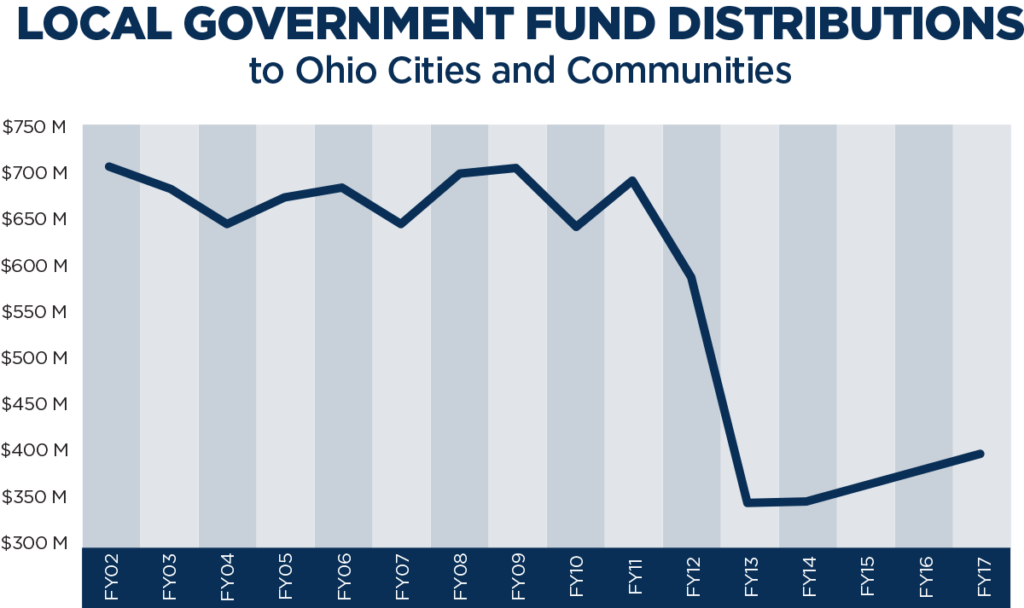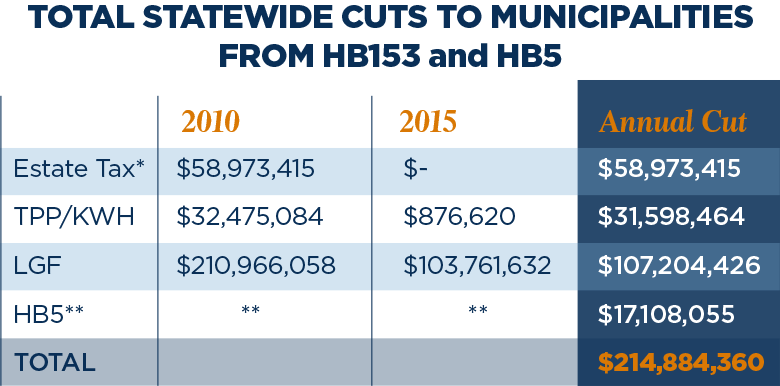What you need to know about Ohio Politics and Policy
Terra Goodnight · January 25, 2017
IO On the Budget: Ohio’s Cities and Local Communities
Our state is only as strong as our cities and local communities. Yet, over the last six years, thanks to moves by Governor Kasich and state legislators, the State has cut or eliminated essential funding to cities by over $1 billion. As we await the release of Governor Kasich’s budget proposal next week, we are watching to see whether this trend will continue, or if state leaders will reinvest in cities to help fight the heroin epidemic and build a stronger economy.PAST BUDGETS: CITIES HAVE BEEN CUT 4 DIFFERENT WAYS
Nearly one-third of all Ohioans live in Ohio’s 30 largest cities, and over 90 percent of state GDP is generated in Ohio’s 11 largest metro regions. Yet, among the most significant budget trends over the last six years has been the state’s massive divestment from Ohio’s cities and local communities.
The primary revenue sharing program for cities and local communities is the Local Government Fund (LGF), which is based on a percentage of the state’s general revenue. In 2011, that percentage was cut in half from 3.33 to 1.66 percent, reducing LGF funds to communities from $695 million to $349 million beginning in 2011 (source: spread sheet on LGF Distributions).
- The largest 30 cities in Ohio have lost an estimated $107 million a year in LGF cuts, but these cuts are not the only cities have faced.
- During this same timeframe, the state also eliminated the estate tax, costing the top 30 cities $59 million a year on average.
- The state ended a tax reimbursements (TPP and KWH) promised when the state eliminated major local business taxes in 2005, which has resulted in an estimated $32 million a year.
- And lastly, cities are still estimating the impacts of the recent passage of House Bill 5, but one estimate suggests that cities could lose as much as $17 million a year.

CURRENT CHALLENGES: ON THE FRONT LINES OF JOB CREATION AND PUBLIC SAFTEY
Facing this budget pressure as result of state cuts, local communities are faced with a choice of cutting services or raising local taxes. In 2016, 4 of Ohio’s largest cities were forced to ask voters to increase the local income tax rate. At the same time, cities are fighting on the front lines of Ohio’s opioid addiction crisis. Three of Ohio’s largest cities among the top 10 in terms of drug fatalities nationwide (Dayton, Cincinnati, Toledo). Statewide, in 2014 Ohio tallied more deaths due to drug overdoses than any state but California. The costs to city are diverse and significant. Here are a few examples of how the opioid crisis is hurting our cities:- Middletown estimates that $1.5 million of its annual budget went to fighting the problem.
- Police, fire and EMS runs are rising dramatically; Dublin estimates 70 percent of property crimes are committed by addicts.
- Cities train & equip first responders to administer Naloxone. Columbus Fire used $150,000 of the drug in one year & announced it will be stocked on police patrols.
- Municipal Courts are establishing special dockets to deal with drug cases, though some have been shuttered due to budget pressures.
- Health departments are seeing more Hepatitis C, which can cost $100,000/person to treat; many cities are looking at needle exchanges like the $300,000 effort in Columbus
WHAT’S NEXT: MORE CUTS TO COME?
Going into the next biennium, lawmakers are faced with the loss of nearly $600 million in sales tax revenue on Medicaid managed care providers, thanks to a federal ruling that the tax was improperly applied. In addition to losses at the state and county level, the state’s 8 regional mass transit systems will lose a combined $40 million. Governor Kasich has indicated that any replacement included in his budget will be temporary, likely dealing another blow to Ohio’s already underfunded transit systems, which provide access to jobs for many urban residents. Cities can be engines of economic growth, but that growth will be short-changed if the state continues to underinvest. As we look towards the next state operating budget, let’s hope that state rethinks its important partnership with cities and local communities.Tagged in these Policy Areas: Ohio State Budget


